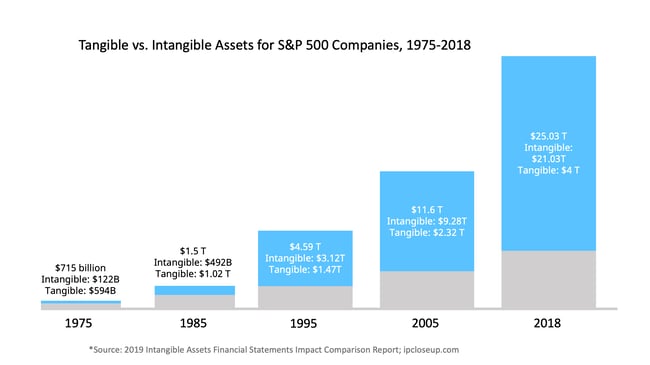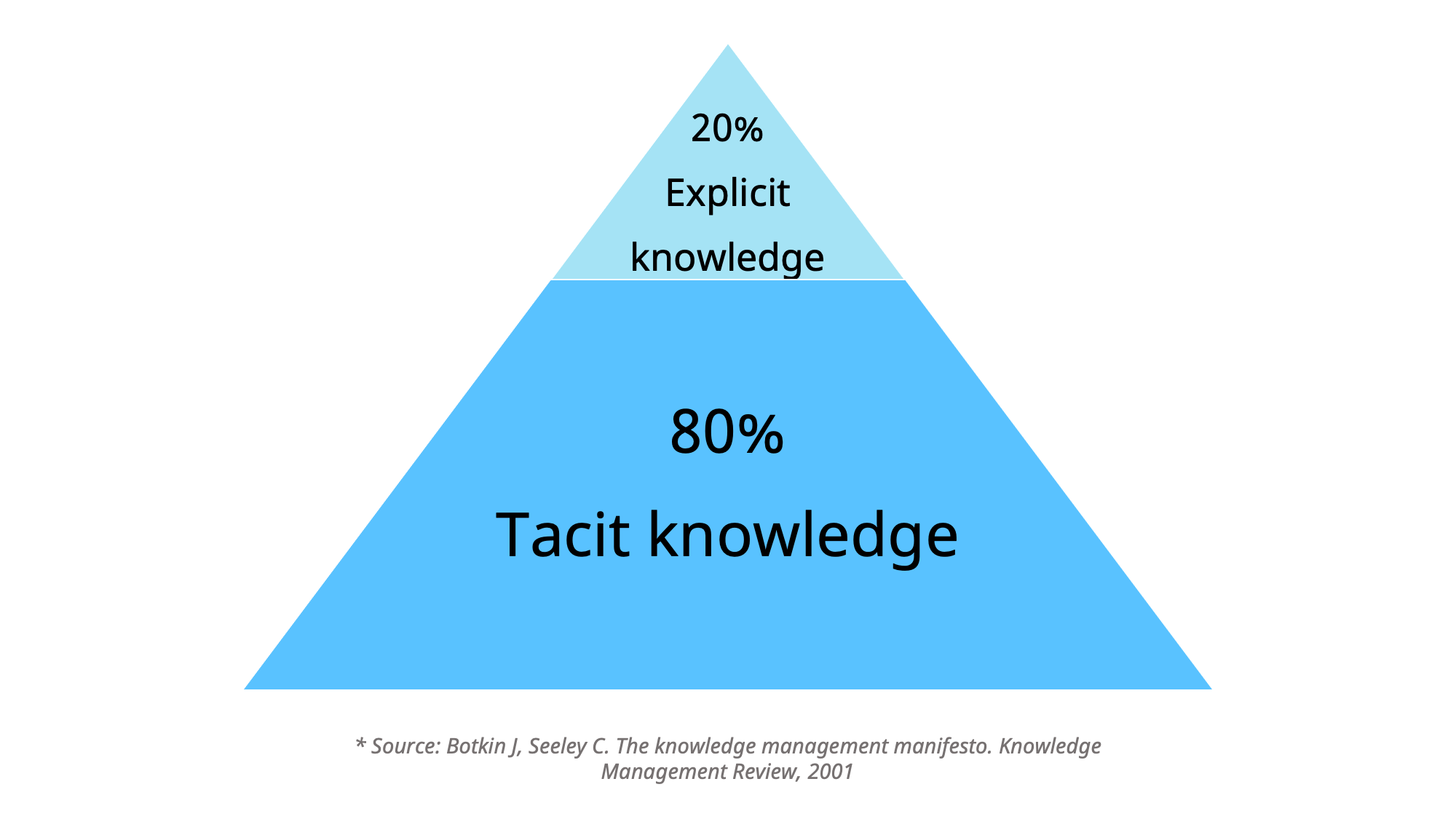Accessing Tacit Knowledge to Drive More Innovation
The value of intangible assets in organizations is nowadays five times greater than the one of tangible assets. In fact, 84% of value in S&P companies is currently represented by intangible assets, like intellectual property, knowledge, or brand recognition, compared to merely 16% for tangible ones.

Even so, some leaders still have difficulties in grasping the power of knowledge and how it can be leveraged and managed to drive more innovation in their organizations. One of the biggest challenges for these leaders is that the majority of knowledge that makes more innovation happen is tacit, and therefore it’s harder to tap into its full potential through the traditional methods: processes, procedures and policies available in databases and documents.
Unfortunately, companies that were not able to keep up with these changes in value distribution faced difficulties and were surpassed by those that leveraged tacit knowledge better. Now, the question that arises is how top companies tap into the full potential of tacit knowledge.
So, in today’s article we’ll explain how different types of knowledge trigger innovation, what is the true value of tacit knowledge, as well as some practical tips on how to make the most of tacit knowledge.

Table of contents
Explicit, implicit, and tacit knowledge and their role in driving innovation
Before diving into the practical things, we'll go through some theoretical aspects which can help clarify the reasoning behind some actions. There's a lot of literature on tacit knowledge and knowledge management which you can explore more in depth if you're interested, but for the purpose of this article we chose the essential information which can serve leaders, managers and decision-makers who want to tap into the potential of tacit knowledge.
The goal of this article is not to offer a perspective rooted in cognitive science and we are aware that there are different interpretations and a variety of opinions on the topic. That being said, let's get to it.
Knowledge, especially tacit, is hard to quantify and measure, which makes it elusive and difficult to capture, but its role in driving innovation is undeniable. To exploit its innovation potential, it’s essential to understand the different types of knowledge, how they can be managed and how they come into play in an organization.
For this, we’ll briefly explain the three main types of knowledge and their role in making innovation happen.
First, there is explicit knowledge, which is the easiest to manage and understand. It’s the most basic type of knowledge that can be collected and transmitted throughout an organization. It comes from organizing, structuring, and processing data and it’s usually stored in databases or files like internal documentation, reports, analytics and financials, process maps, handbooks, and so on.
For example, all metrics and KPIs are forms of explicit knowledge. Explicit knowledge supports everyday improvements which primarily leads to incremental innovations.
Explicit knowledge supports everyday improvements which primarily leads to incremental innovations.
Next is implicit knowledge, which oftentimes is put under the same umbrella with tacit knowledge. However, we prefer to separate the two because there are small differences in how you should manage them in practice.
Implicit knowledge is essentially explicit knowledge applied: how we make use of existing information and put it into practice. Each of us has different past experiences and ways of thinking. As you’ve probably seen, that means that we can draw different conclusions from the same data, and thus apply the same explicit knowledge in very different ways.
This is true especially when we think of how people communicate and transfer information. For example, when we create a report or a presentation, even if we work with the same data points and results, different people may choose to focus on different pieces of information and tell a very different story.
Last, but not least, is the focus of this article: tacit knowledge. Tacit knowledge refers to the wisdom we accumulate through experience but that is not codified or clearly expressed. These are the things we know but can’t really put into words. Think cognitive skills, mental models, intuition, and general know-how.
Different sources are citing various figures of how knowledge is distirbuted in an organization. From 80% all the way to 95%, tacit knowledge seems to be the bottom of an iceberg, hidden under water. Regardless of what the specific number really is, it's probably safe to say, that the vast majority of information is tacit.

It’s believed that turning tacit knowledge into explicit knowledge is extremely difficult because of its nature. Many times, when we think we articulate or codify tacit knowledge, we might deal with implicit knowledge instead. Why is it then so hard to capture tacit knowledge – and should we even try to make it explicit?
In practice, people often aren’t aware of the tacit knowledge they possess, and that’s a big part of what makes it so elusive. Transferring know-how and cognitive skills requires regular contact, interaction, and trust between people. When this can be turned into a conscious, systematic effort, that’s when we start to get its value and make the best of it.
The importance of tacit knowledge and how to make the most of it
In the era of information technology, it’s so easy to become obsolete, that retaining and acquiring knowledge has become a central focus for most organizations.
Today most companies recognize employees’ talent and knowledge as a major competitive advantage. We’ll explain later in the article why most innovations and breakthroughs don’t come from explicit, but from tacit knowledge.
Losing employees with the tacit knowledge that hasn’t been passed on can lead to the inability to complete projects or meet strategic targets. For example, an engineering company lost its dominant market position simply because it lost the experienced engineers that major clients were looking for. Typically, that relationship isn’t as obvious, but the same principles still apply. The most talented or experienced employees create dramatically outsized returns for the organization.
As already mentioned, explicit knowledge refers to the public information, which would be easily accessible if desired, because it can be codified and transmitted in writing. As we know, such knowledge generally contributes to incremental improvements, but breakthrough innovations require truly novel knowledge, and that usually starts at an individual level.
Breakthrough innovations require truly novel knowledge, and that usually starts at an individual level.
From a highly experienced floor worker who comes up with ideas to streamline processes to a researcher’s insights that help develop a new product, the key is to make this individual knowledge available to others. That is one of the main sources of competitive advantage in knowledge-centric companies.
How tacit knowledge impacts organizational performance
Traditionally, knowledge isn’t systematically measured against financial results, so some executives might not be aware of how knowledge loss impacts their performance. It’s understandable, given that it’s easier to measure and track the impact of tangible assets, so the focus usually goes in that direction.
However, nowadays we have plenty of research that supports the idea that losing knowledge has a significant negative impact on an organization’s performance. This helps us better understand how losing tacit knowledge affects the bottom line. At the same time, if leaders can articulate the role of tacit knowledge, they can also assess the real costs of managing it and raise awareness on the investments required to create, retain, and transmit it.
Losing knowledge capital can affect the performance of an organization in different ways.
From reduced organizational capabilities or ability to achieve strategic objectives, to disruptions, increased time to accomplish tasks, increased costs, or reduced customer satisfaction.
Let’s take the example of a company where a veteran sales executive who played a major role in dealing with important customers is leaving the organization. His strong customer relationships developed over the years could affect the firm, leading to a loss of up to $ 10 million. The business will not only lose significant revenue but its ability to acquire new ones will also diminish.
In such cases, the external social capital is useful for the organization at large. Having access to a diverse external network allows people inside the organization to tap into a wide range of information.
On the other side, when these connections are exclusively internal, politics can get in the way and affect the transparent flow of information.
To summarize, losing knowledge capital can affect the performance of an organization in different ways. From reduced organizational capabilities or ability to achieve strategic objectives, to disruptions, increased time to accomplish tasks, increased costs, or reduced customer satisfaction.
On the other hand, if you focus on developing a knowledge-creating company that encourages continuous learning, interaction, and constant dialogue you will see additional benefits, as well as positive impact on the bottom line.
By now, you’re surely thinking what all this theory means in practice, so let’s take a look at that next by going through some methods that can help reap these benefits.
How to capture tacit knowledge
As already mentioned, turning tacit knowledge into explicit knowledge requires some work and effort, but by starting with baby steps like getting people to share thoughts, issues, or ideas on a regular basis you are already one step ahead.
We believe there’s no need to overcomplicate things and the good news is that something as simple as gathering ideas will force people to turn their tacit knowledge into something more tangible. Obviously, each organization has its share of bad ideas, but even so, it’s still a great way of bringing people’s insights to the table because it can uncover new opportunities, sometimes even unrelated with the idea itself.
It might not be the first thing that comes to mind when trying to access tacit knowledge, but an idea management tool can help you turn it into a systematic, continuous practice that on the long run, can lead to more innovation.
 However, at the end of the day, a tool is just a tool. It helps you organize your processes better, automate tasks, and facilitates easy communication. The complexity and nature of such methods and processes varies greatly from one organization to the next.
However, at the end of the day, a tool is just a tool. It helps you organize your processes better, automate tasks, and facilitates easy communication. The complexity and nature of such methods and processes varies greatly from one organization to the next.
If you are operating in an industry with higher risks, codifying tacit knowledge becomes even more complicated. A continuous ideation process could reveal new creative ways of accessing it as well as maintain communication and a constant flow of information.
To put things in perspective, let’s take the example of a maintenance technician who retired from a plant that produced soybean oil. After he left, the produced oil quickly started to go bad. It took the company two years and cost them millions of dollars before they realized that the maintenance worker had been changing a seal on the machines that pressed the oil every week, instead of the eight weeks that was instructed in the maintenance manual.
The first reaction would be to blame the technician for not transferring that information before leaving, but in reality, it’s the company’s responsibility to have in place processes that ensure smooth transfer of information and knowledge.
It’s the company’s responsibility to have in place processes that ensure smooth transfer of information and knowledge.
Managers and leaders should be aware of these differences in procedures and in this particular case the mistake could have been easily avoided with a better process of documenting the steps taken to produce the soybean oil.
As this example shows, different organizations need different processes at various levels of complexity. Developing those processes that support knowledge creation and retention is still up to you, so let’s have a look at three simple steps that can make a big difference.
- Bring to the surface the knowledge losses and the risk associated with that. What knowledge supports the strategic objectives and business goals? To run a diagnosis process you could, for example, start with a series of interviews that will help you surface potential issues.
Here’s where you want to identify the critical knowledge that might be lost and its impact, the interviewees perception of existing knowledge and the transfer processes and opportunities to leverage knowledge in case employees leave. - Map the employees and the roles whose knowledge is essential and play a key role in transmitting it. The previous step can also guide you in creating this map or list.
- Create the environment and practices that encourage socialization and interaction. Since tacit knowledge is about the know-how and the skills we acquire through experience, these are best learned through emulation, imitation, and repetition.
Best practices for accessing tacit knowledge
These are three first steps that could be applied in any organization, regardless of their profile. They can become the foundation for a more thought-through process which you can develop in time. On a more practical level, the methods and processes you decide on, can be supported by some of these best practices:
Build a continuous improvement culture as it helps to reinforce the social capital.
It encourages contribution and collaboration between people. It enables networks of relationships that help the organization function effectively. When these connections are strong and built on trust and transparency, they facilitate the transfer of know-how and other skills that otherwise would be lost.
Encourage constant social interaction and exchange of ideas
As already mentioned, tacit knowledge is about the know-how and the skills acquired through experience. These skills are better transmitted through emulation, mentorship, and repetition. This knowledge is deeply embedded in people’s minds and human interactions are essential to facilitate the transfer of information.
Make idea generation and collection a systematic process
This won’t help you just to find answers and solutions to specific problems but also to uncover opportunities that have an impact on the entire organization. Collecting ideas systematically enables the entire workforce to get involved and build on each other’s knowledge. Moving from a traditional “suggestion box” to a more wholistic and transparent approach with an idea management tool can dramatically help in sharing and making knowledge more accessible.
Collecting ideas systematically enables the entire workforce to get involved and build on each other’s knowledge. Moving from a traditional “suggestion box” to a more wholistic and transparent approach with an idea management tool can dramatically help in sharing and making knowledge more accessible.
Encourage storytelling in different forms
You can create a “lessons learned” database where people can learn about successes and failures that lead people to acquire their knowledge. The best way to tell these lessons, might be through stories.
Storytelling is a powerful tool because it allows people to reflect on their learnings. Essentially, you want people to share their (true) stories that serve as metaphors which make difficult-to-grasp information easier to digest and understand. Stories are powerful because they convey meaning and knowledge, not just unconnected bits of information. For example, you can put this in practice through internal newsletters, or casebooks.
Stories are powerful because they convey meaning and knowledge, not just unconnected bits of information.
Create succession planning, retirement policies, and mentoring programs
Retirement is one of the causes of knowledge loss and some companies don’t tap into the tacit knowledge of older employees. The loss of experienced employees can threaten core capabilities that rely on complex experiential knowledge. Organizations should have mentoring programs to train less experienced employees, as well as retirement policies and plans that help maintain the balance of the workforce.
Examples of codifying tacit knowledge:
As you’ve seen so far, there are different factors that can help you either capture tacit knowledge or turn it into explicit knowledge. And as mentioned, sometimes learning new things also comes from emulation and imitation. With that in mind, let’s see what other companies are doing to address the issue of tacit knowledge and think of what you could also learn from their experiences.
Matsushita Electric
The first example is one that helped popularizing the concept of tacit knowledge as well as the idea that it supports innovation.
 In 1985 Matsushita Electric, now Panasonic, was working on creating a better home bread-machine. However, they lacked the knowledge a baker had. So Ikuko Tanaka, a software developer at Matsushita decided to learn from the best. He trained with the master baker at The Osaka International Hotel and observed the technique he had for kneading the dough.
In 1985 Matsushita Electric, now Panasonic, was working on creating a better home bread-machine. However, they lacked the knowledge a baker had. So Ikuko Tanaka, a software developer at Matsushita decided to learn from the best. He trained with the master baker at The Osaka International Hotel and observed the technique he had for kneading the dough.
The know-how of the baker, his special stretching technique, was the tacit knowledge that Matshushita was lacking, and that Tanaka was able to uncover and reproduce through imitation and observation. After working with the baker, experimenting, testing and developing the product, Matsushita created a final product that led to record sales.
Rolls-Royce
Even though it’s not a recent example Rolls-Royce is still a good case to look into. Rolls-Royce turbojet engines powered Concorde, the aircraft that introduced supersonic air travel to the world. The Rolls-Royce engineers held most of the knowledge on how to maintain the sophisticated supersonic jet engines and many of them were preparing for retirement.
Before the Concorde was retired in 2003 the company identified how the big number of retirements would impact their key capabilities. This helped them prepare for uncertainties and decide on future investments.
Bessemer
Last, but not least, an example that takes us even farther back into the history is Henry Bessemer and his patent for an advanced steelmaking process. Bessemer sold his patent, but he was later sued because they couldn’t make it work. So, Bessemer set up his steel company because he knew best how to do it, even though he wasn’t able to articulate it.
As you can see from these examples, tacit knowledge spans its impact in various areas and at different levels in each organization. So, it’s important to remember that tacit knowledge plays an important role in all stages of innovation.
It can be in the early stages, where there’s a higher degree of ambiguity so more knowledge to be harnessed. Or, it can be in the later stages of innovation, where execution and implementation require you to tap into the tacit knowledge of your employees to speed up the process and get better results
Conclusion
“We can know more than we can tell”, said Polanyi, the one to whom we attribute the concept of tacit knowledge. We couldn’t agree more. We can’t possibly articulate everything we know, so we need to find other means to go about it.
As leaders, managers, or someone with decision-making powers, you have to maximize the opportunities of expressing this knowledge. You can choose to develop a culture of innovation where continuous learning, improvement and knowledge exchange are encouraged and sustained. With a strategic and systematic approach, the flow of information will become more natural and easier to manage.
You can start small today, by collecting ideas, suggestions, and opportunities with the help of an idea management tool. If you are not sure how to get started with this, book a demo to see how it works in practice.





